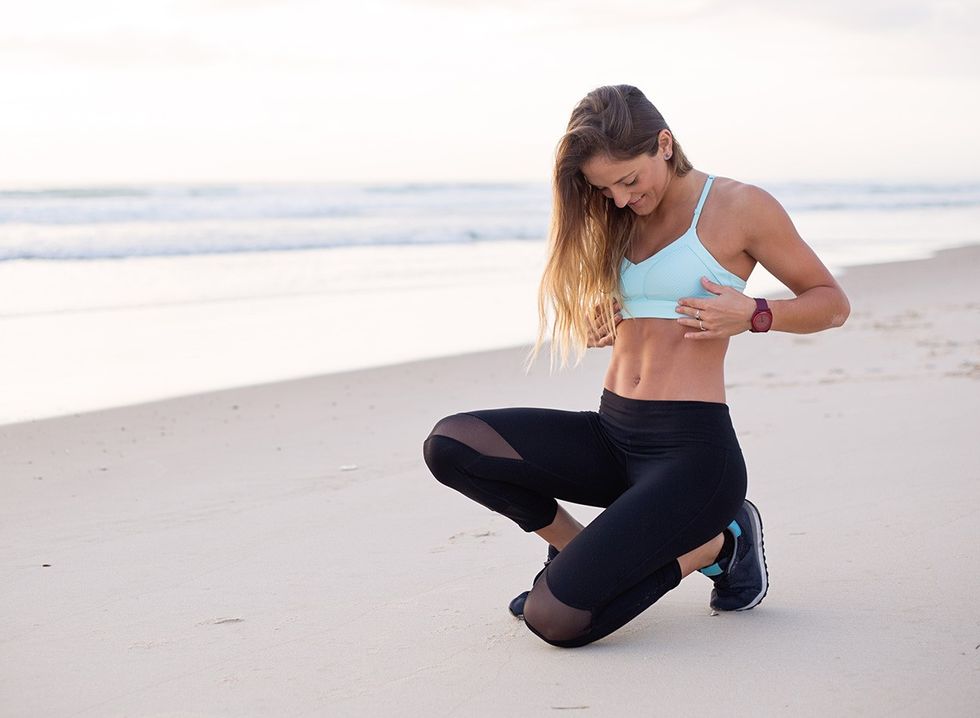People often ask me how to get a solid core, and I know why: My degree is in kinesiology with an emphasis on anatomy. I continued my education in exercise physiology and health-related sciences. Not to mention, I have multiple certifications such as but not limited to:
- Certified personal trainer
- Certified performance enhancement specialist
- Corrective Exercise Specialist
- Certified Pilates instructor
- I also worked in a physical therapy office for 15 years.
- I also worked as a contracted injury prevention specialist for 2 large entertainment corporations.
But the real reason I get asked is that my clients want to look good and feel good, and believe it starts with abs or a flat belly, aka, in their minds, "the core."
Core health is often a misunderstood term. The most common misunderstanding is that the core is just the abdominal muscles. When a doctor tells a patient to strengthen their core, the assumption is sit-ups or crunches. Core stability and strength include the abdominals and the deeper intrinsic core muscles and the muscles of the back and the muscles that attach to the pelvis, including the glutes.
All the muscles in the trunk: Rectus abdominis, transverse abdominis, the erector spinae muscles, the multifidus muscles, the internal and external obliques, the glute complex, the latissimus dorsi. (Just to name a few because the list is incredibly long.)
You might get the following health issues with a weak core: general Fatigue, weakness, digestive issues, from a weak abdominal wall increased risk for injuries to the neck, shoulders, back, hips, and knees. balance issues also arise from a weak core, which leads to an increased risk of falling and thereby incurring injuries.
1. Start With Strength Training and Pilates

As stated before, increasing core health is not just doing sit-ups and crunches. Core health includes strengthening muscles in the glutes, the legs, the back, the deep intrinsic pelvic floor muscles, and the abdominals. There is not one specific exercise that is the magic cure for core strength.
That said, Pilates and strength training are some of the most effective ways to strengthen all of the muscles in the core.
Related: How to Lose 15 Pounds of Fat in 3 Weeks, According to Weight Loss Expert
2. Even Better, Find a Strength-Training-Based Pilates Class

Find a strength-training-based Pilates class. At Mantra, we focus on strengthening the entire body, as one complete functioning unit; this includes leg and glute exercises, upper body and arm strengthening. And of course, focused abdominal and core work.
3. Focus on the Muscles That Surround Your Spine

Focusing on the muscles that surround the spine, while maintaining mobility and essential movements of the spine as a focus. This includes muscles that surround the trunk, both front and back body.
4. Don’t Forget About the Obliques

Don’t forget about the obliques, this group of muscles wraps from back to front, around the side body. This muscle group helps with movement such as lateral flexion, extension, and flexion of the spine and of course rotation.
5. Remember There's All Types of Movement

Exercises for the core and obliques aren’t just done in one singular plane or motion; core exercises focus on all types of movement such as flexion (rounding of the spine), extension(think of arching the back), rotation (twisting the torso), lateral flexion (side bending) and hinging (bending at the hip line.) Front line core work such as crunches and sit-ups work, but also prone planking exercises. Incorporating these types of movements into your workout regime help solidify the core.
6. Plank in Proper Alignment

Planking incorporates more muscles of the core, but must be done in proper alignment. Too often, improper planking can lead to shoulder pain and low back pain,
7. Work Your Legs

Core strength and stability also comes while working legs. The glutes attach at the pelvis area and then like train cars attach to lower leg muscles. Making sure the abdominal and pelvic floor muscles are engaged during lunging and squatting is essential to help maintain proper positioning. Split stance lunges can really tap into deep intrinsic pelvic floor stabilizing muscles, but they have to be engaged throughout the entire movement.
8. Brace Your Belly

While training upper body movements, remember to brace into the belly and maintain proper alignment into the spine. Even though the arm work is the focus, keeping the abdominals and core muscles active this will continue to strengthen the core. Proper spine alignment can also help strengthen the back muscles.
Related: The #1 Right Way to Lose Lower Stomach Fat
9. Target Appropriately

When doing core focused movements, it’s important to find the proper alignment and muscle utilization. When doing plank or crunches you want to make sure that the hip flexors aren’t over tightening and being the prime mover. We want to find the abdominal and core muscles and make them the prime target. We want to maintain proper lumbar spine alignment as well.
10. Tap Into Core Awareness

While doing movements that most people feel aren’t specifically targeted at the core, remember to tap into core awareness in order to help prevent injury and maximize the effectiveness of the exercise
11. Incorporate Balance Movements

Incorporating balance movements, single leg movements, or movements done on an unstable surface can really bring awareness to core stability.
12. Breath Work is Essential

Breath work while training is essential: Inhale to fill up the back of the lungs, and as you exhale the air empties lungs and the diaphragm engages, which then helps deepen core engagement and strengthening.
13. Engage Constantly

Always remember it’s not just engaging the muscles at the beginning of an exercise, but constantly throughout the entirety of the movement.
14. Focus on Mobility

Focus on mobility in the pelvis attachments and spine, Hip Flexor and hamstring stretches, glute stretches and rotational stretches. Maintaining mobility and strength in the spine and core really complement each other.
15. Shut Off Your Phone

Ineffective training is something we should all avoid. When choosing to participate in an exercise program, be present. Focus on alignment, breathing, and mind to muscle work. Shut off the phone and text messages, eliminate distractions and focus on making the most out of the time while you are working out.
Related: I Lost 40 Pounds in 5 Months with This Diet Trick
Pilates for Life!

For me, it’s all about applying my Pilates principles to every day, life, and every type of exercise I choose to engage in.
No matter what exercise regime you choose to participate in, having proper posture, alignment, and core engagement is essential to not only preventing injuries, but decreasing the risk of injuries in everyday life.
Strength training-based Pilates is an excellent complement to any type of activity. For example, if you are a runner participating in a functional strength training-based Pilates class, it will enhance your running speed and times.
Paige Johnson is a fitness instructor at Mantra Fitness.















 Shutterstock
Shutterstock Shutterstock
Shutterstock Shutterstock
Shutterstock Shutterstock
Shutterstock Shutterstock
Shutterstock Shutterstock/sakkmesterke
Shutterstock/sakkmesterke


 Shutterstock
Shutterstock Shutterstock
Shutterstock Shutterstock
Shutterstock Shutterstock
Shutterstock Shutterstock
Shutterstock Shutterstock
Shutterstock Shutterstock
Shutterstock Shutterstock
Shutterstock Shutterstock
Shutterstock Shutterstock
Shutterstock Shutterstock
Shutterstock Shutterstock
Shutterstock Shutterstock
Shutterstock Shutterstock
Shutterstock



 Shutterstock
Shutterstock Shutterstock
Shutterstock Shutterstock
Shutterstock Shutterstock
Shutterstock Shutterstock
Shutterstock Shutterstock
Shutterstock Shutterstock
Shutterstock Shutterstock
Shutterstock Shutterstock
Shutterstock Shutterstock
Shutterstock Shutterstock
Shutterstock Shutterstock
Shutterstock

 I'm a Nutritionist and These 9 High-Protein Snacks Keep My Clients Full While Losing 50 Pounds
I'm a Nutritionist and These 9 High-Protein Snacks Keep My Clients Full While Losing 50 Pounds
 Shutterstock
Shutterstock 2. Processed FoodsShutterstock
2. Processed FoodsShutterstock Shutterstock
Shutterstock Shutterstock/Prostock-studio
Shutterstock/Prostock-studio Shutterstock
Shutterstock Pro TipsShutterstock
Pro TipsShutterstock Shutterstock
Shutterstock Shutterstock
Shutterstock Shutterstock
Shutterstock Shutterstock
Shutterstock Don’t Drink as Much AlcoholShutterstock
Don’t Drink as Much AlcoholShutterstock Most Women on GLP-1s Are Making a Few Common MistakesShutterstock
Most Women on GLP-1s Are Making a Few Common MistakesShutterstock Soda and Sugary DrinksShutterstock
Soda and Sugary DrinksShutterstock Shutterstock
Shutterstock Eat BreakfastShutterstock
Eat BreakfastShutterstock And Improve Insulin SensitivityShutterstock
And Improve Insulin SensitivityShutterstock Belly Flab Strip Tip: Sugar and Fat Calories Leave Its Mark on Your BodyShutterstock
Belly Flab Strip Tip: Sugar and Fat Calories Leave Its Mark on Your BodyShutterstock Shutterstock
Shutterstock The Drugs Mimic the GLP-1 Hormone Naturally Produced by the BodyShutterstock
The Drugs Mimic the GLP-1 Hormone Naturally Produced by the BodyShutterstock 3. Deep-Fried ItemsShutterstock
3. Deep-Fried ItemsShutterstock